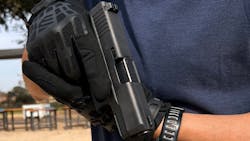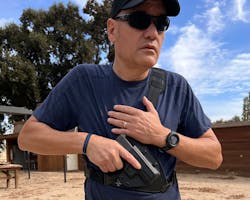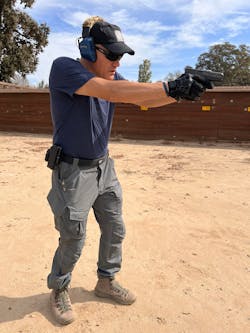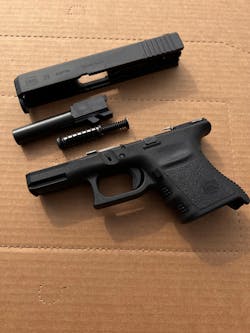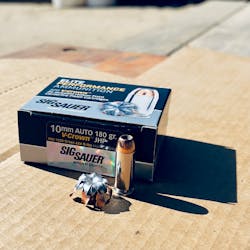Glock 29SF Review: Gun to Have Against a Charging Target
I tested a Glock 29SF, a 26.81 oz subcompact handgun designed around the 10mm cartridge, and some Alien Gear Holsters to match. Despite the power of the 10mm cartridge, the 29SF was easy to handle and delivered accurate fire.
This article appeared in the January/February issue of OFFICER Magazine. Click Here to view the digital edition. Click Here to subscribe to OFFICER Magazine.
The 10mm
The 10x25mm cartridge was designed in response to the marginal performance of other handgun cartridges during the 1980s. This response was based on actual law enforcement incidents. By this time, many agencies had recognized the utility of the semi auto handgun, specifically the 9mm.
In 2022, cartridge making technology has closed the gap amongst the common law enforcement cartridges; 9mm, 40 and 45. However, in 1989, when the 10mm was briefly adopted by the FBI as a duty cartridge, the 10mm provided the power and magazine capacity considered necessary for duty.
After a short installation, it was found that guns designed around the 10mm favored larger hands, and 10mm recoil was a bit heavy for a duty gun. Shortly after, the 40 S&W, a happy medium, was born. The popularity of the 10mm waned, as the 40 S&W could do many of the desirable tasks of the 10mm. Additionally, the 40 S&W could be retrofitted into 9mm handguns.The 40 S&W has lost some of its luster also. I have been testing cartridges for over two decades and have been fortunate to have been intimate with the advances in technology. Over time, these advancements made the characteristics of the 9mm close to the 40 S&W, ballistically speaking. Bullet makers got good at controlling expansion rate, allowing the 9mm to penetrate more and expand at the ideal penetration.
Don’t misunderstand. These advantages were applied to all cartridges. The 40, 45 and 10mm enjoyed them as well. It’s just that the 9mm of today is better than the 40 of only a few years ago. All of these ships rose in the rising tide.
Now, nearly every agency has adopted the 9mm, with its higher velocities, controlled expansion bullets, and the newer formulations of cleaner powders. These powders even have reduced flash, for follow up shots in reduced lighting.
With all of these great improvements, why would we be interested in testing an almost archaic caliber for law enforcement use? The answer is simple: The 10mm can do things that other cartridges cannot do.The Glock 29SF
The Glock 29SF is a Glock Safe Action handgun, typical of the Glock design. Designed for concealed carry, it is the 10mm equivalent of the G27, in 10mm. Like similar models, the G29SF will accept magazines from the duty sized Glock 20 and Glock 40. The 29SF has a 3.78” barrel, and weighs 26.81 ounces empty.
The “SF” designation stands for Short Frame, which means it has improved ergonomics for smaller hands. The 45 ACP Glock variants are pretty fat, precluding shooters with smaller hands. The SF design reduces the backstrap to trigger dimension, allowing for a little comfortable grip. Both the 29SF and Gen 4 Glock 29 have basically the same dimensions, which I found to be much more comfortable than the fat 45s. However, I need to be clear here: this is not a gun for small hands.
The 10mm is a flying hammer, and the Glock design has tamed the recoil a little. I was able to shoot the 29SF comfortably, even with 220 grain rounds. Glocks have a typical machine-like accuracy, and one can easily shoot this gun accurately at 25 yards.
This brings up my first argument for this gun in law enforcement. There are some duties where the officer cannot carry a rifle, but the tactical situation really calls for a carbine. Picture an enforcement duty that involves tasks such as rope or water rescue, where the officer may need to defend himself at carbine distances. This gun is almost pocket sized, but shoots one of the flattest, most accurate semi auto handgun cartridges that’s seen LE duty.
The terminal performance of a 180-200 grain supersonic bullet is a better choice than a light 9mm. Considering the fact that the magazine capacity of the 10mm is not significantly less than the 9mm, it is the obvious choice.
The 45 is pretty powerful. It transfers from 350-450 foot pounds of energy, using bullets that range from 160-230 grains that can travel roughly 800-1100 fps. The 10mm tosses 165-220 grain bullets from 1100-1300 fps, transferring 550-675 foot pounds of energy. The 10mm is definitely the standard for powerful duty cartridges, and we found the Glock 29SF was at least as accurate as any contemporary duty guns.
We fired the Sig Sauer 180 grain V-Crown JHP rounds through the 29SF. They proved to be accurate, gave 170% expansion, and stopped at the 18” mark in gelatin.
This is another reason why any law enforcement agency would adopt the 10mm.
It has enough penetration to take down some creatures dangerous to humans. It may also be a good firearm where the Officer may occasionally need to dispatch an injured animal.AlienGear
The Glock 29SF is thicker than the 9mm Glocks, and it doesn’t fit the G19 holsters. I picked the Alien Gear Core Carry Pack, the Shape Shift system, because they are comfortable.
Like the original Alien Gear line, the Shape Shift system is based around a shell that can be added to several different platforms for the same gun. The advantage here is for the officer who changes duty assignments, or deploys in different uniform assignments over the years.
The Shape Shift Modular Holster System has four basic configurations: IWB, Appendix, OWB paddle, and OWB slide. In addition to these configurations, the retention level and tension can also be adjusted. For example, the first way I set it up was to use the OWB panel system with the thumb release, which is an extra level of retention. This set up has a natural jacket slot and an adjustable cant. I used this set up throughout the first part of the range testing, until I swapped it out for the OWB Slide set up. This configuration uses only half of the larger shell, and an abbreviated version that rides against the waistband.
The most popular set up is the AIWB, which uses the major components from the OWB, except that it has a unique appendix clip. Compared to similar holsters, the injection molded custom fit and the comfortable backing makes it keeps the gun in place. The IWB configuration is almost luxurious in the fact that it has a full backing of padded material against the body.
I also experimented with the Alien Gear Cloak Chest Gun Holster. This rig uses the original shell configuration from Alien Gear. I use a chest rig for fly fishing and this has a superior design. It is the fact that the padded weight bearing strap comes over the non-firing shoulder, without any risk of sliding off the shoulder, making the user feel like they are being constantly choked by the holster.
For a Search and Rescue setup, I pick the Glock 29SF and the Cloak Chest Gun Holster. It is secure enough so the officer doesn’t have to worry about the firearm while on duty. It gives an extremely intuitive draw, giving the working rescuer a protective posture if the situation rapidly changes.
For fly fishing, it’s a great set up when curious creatures become aggressive ones.
I personally can make a longer range shot with a 10mm than any other handgun cartridge. For waterborne operations, where engagement is from watercraft to watercraft, or similar longer ranges, it is a good idea to have a bullet that has energy at the end of its journey. The 10mm has higher velocity, and therefore higher energy transfer at longer ranges.On the range
I rigged together my Glock 29SF and The Alien Gear OWB Paddle holster. Using 220 grain bullets, I was able to fire some promising groups at 15 yards. The gun is easy to handle, and the wide backstrap allowed more comfortable shooting than I expected. There are several 10mm products out there, but the 29SF is one of the more comfortable ones to shoot.
It is unrealistic to say that the 10mm will ever displace anything in an agency’s inventory. It will, however, be the gun I’d like to have when the target is charging, and backup is miles away.
About the Author
Lindsey Bertomen, a retired police officer and military small arms trainer, has taught shooting techniques for over a decade, in addition to teaching criminal justice at Hartnell College in Salinas, California. Off the clock he enjoys competing in shooting sports, running and cycle events. He welcomes comments at [email protected].
This article appeared in the January/February issue of OFFICER Magazine.

Officer Lindsey Bertomen (ret.), Contributing Editor
Lindsey Bertomen is a retired police officer and retired military small arms trainer. He teaches criminal justice at Hartnell College in Salinas, California, where serves as a POST administrator and firearms instructor. He also teaches civilian firearms classes, enjoys fly fishing, martial arts, and mountain biking. His articles have appeared in print and online for over two decades.
